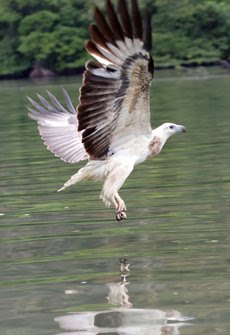
The eagle feeding is indeed unnatural and is bad for the eagles for a few reasons
1) reliant on human feedings, after a few generations, the eagles of langkawi are no longer majestic as they only swoop down and skim the water for human waste.
Will they gradually loose the ability to hunt?
2) Anitbiotics, growth hormones, beta agonists etc injected into our poultry like chicken are being fed to the eagles. It not only causes the bird's immune system to go haywire and cause disease, hormonal changes may affect the bird's ability to breed.
3) Prolonged contact with humans will cause the eagles to loose their natural apprehension and fear for humans. This will make hunting etc all the more easier.
4) How much have we learned from the eagle feeding activity apart from visual entertainment? Are we more aware about their breeding habits? Their courtship mechanisms their prey(chicken skin?)
problems they are facing like habitat destruction? What have we learned from the above activity that aids in their protection?
Unless something beneficial comes out of the feeding activity or at the very least does not harm the birds in anyway, please do not support the activcity and make your concerns heard.
Thank you.
I must confess I went for a tour that includes eagle feeding in Langkawi. It's unnatural & bad for the eagles. The eagles made Langkawi their natural habitat & being a top tourist destination, the tour operators capitalised on it by organising such tours.
ReplyDeleteOf course, watching eagles swooping down for food makes the tourist happier. I am now more aware of the environmental impact on the eagles.
Personally, I am more concerned about some zoo operators exploiting animals such as offering them to take photos with paying customers. I have seen baby tigers being chained to the table, waiting for visitors to take photos with them as souvenirs.
Oh, I'm glad to find a convert! :-)
ReplyDeleteThanks to you, I know there's actually people who care.
We really need more people who are aware, proactive and passionate.
The tiger cub you mentioned should be Nicky- the tiger cub born in Zoo melaka. I've seen him being handled so roughly but there's nothing I can do.
On exploitations...
Well, Zoos that are plain-"viewing galleries" (most of the zoos in Malaysia) are exploitations.
They place animals in super mini enclosures without any substantial effort to replicate the animals natural environment. A lot animals end up "broken"- they pace back and forth in their prisons- signs of stress and psychological disturbance.
In my opinion, Zoos should serve three purposes.
1) public exposure and education
2) Animal sanctuary
3) Research for conservation purposes.
1) Most of the time, people classify animals as- FOOD and NON-FOOD. Public exposure is necesary to let people know such an unique animal exists, and the characteristics that define that particular species.
Each species is of course unique and Each individual animal is unique with its own mannerisms and habits- ask anyone who owns a pet. Given a chance, you will find all animals big and small, spiders even.. have their individuality- just as humans do. Personally I've found the same species of insects react to me differently, some are friendly and love to be in the limelight while others are camera-shy and scoot away once my hand approaches.
(For a really good read and to understand animals as well as humans and science, I recommend this book
"When elephants weep"- the emotional lives of animals."
It really helps us see why animals deserve our attention and explains why mainstream science and many religions delegate animals as 'lower beings' A mentality best explained by this example.
When westerners first discovered south africa, australia etc they view the natives there as inferior. Black people are viewed as dumb and stupid, lower beings than the whites- that becomes the justification to use them as slaves.
Once we start acknowledging that animals are smart, intelligent and they have emotional lives, they feel what we feel... we lose the justification to use and abuse them, that's why we find the absolute denial of any animal intelligence, emotionality by the world as a whole.
I can lend you the book if I do see you someday!)
And as they say, you do not protect something you do not love and you cannot love something you do not understand. the public must be exposed so that they can understand...
Education should be aimed at teaching people how their actions affect the environment and what can be done to protect the animals.
2)I believe as an animal sanctuary, animals that are threatened in their natural habitat can be relocated for a time- for breeding purposes, quarantine for disease etc- in an environment that closely simulates their natural habitat. For zoological exhibit, there can be a small viewing area up front for tourists but much of the place should be hidden from view. Offspring of the animals can then be gradually reintroduced into the wild, on the condition that human contact has been kept to a minimum.
3) In zoos the animals are up close and personal and its the place for animal artists, budding photographers and most importantly for researchers to learn about the animals habits, breeding requirements, traits and behavioral patterns that can help efforts to protect the animals. For example, by simply knowing that this particular species breed in the month of september to december can make a lot of difference in safeguarding their future.
I'm so sorry this turned into a mini lecture but I just can't help it! It's so difficult to find an audience in such things and I'm so glad you're here to listen to me go "blah...blah...blah..."
Hope you find my explanation meaningful!